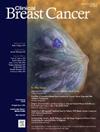A Randomized Phase 2 Study of Neratinib With or Without Fulvestrant for Patients With HER2-Positive, Estrogen Receptor-Positive Metastatic Breast Cancer
IF 2.5
3区 医学
Q2 ONCOLOGY
引用次数: 0
Abstract
Background
Most HER2-positive breast cancers co-express estrogen receptor (ER). Given crosstalk between HER2 and ER signaling pathways, dual blockade may be beneficial.
Methods
In this randomized, open-label, phase 2 clinical trial, patients with ER-positive (ER ≥ 10%), HER2-positive metastatic breast cancer were randomized (1:1) to neratinib (240 mg daily) or the same dose of neratinib with fulvestrant. Any number of prior therapies was allowed; prior trastuzumab, pertuzumab and trastuzumab emtansine were required. The primary endpoint was progression-free survival (PFS). Secondary endpoints included overall survival (OS), overall response rate, and duration of response. Exploratory objectives included the identification of predictive biomarkers via circulating tumor DNA (ctDNA).
Results
Of 21 patients enrolled, 18 were evaluable for outcomes and safety (neratinib-fulvestrant arm, n = 8; neratinib-only arm, n = 10). The study was closed before completing enrollment due to slow accrual. Median PFS did not differ between treatment arms (2.79 months with neratinib-fulvestrant versus 5.55 months with neratinib only [HR 0.94; 95% CI, 0.24-3.64; P = .98]). Grade 3 adverse events occurred in 1 (12.5%) patient in the neratinib-fulvestrant arm and 6 (60%) patients in the neratinib-only arm, with diarrhea being the most frequent. Median OS did not differ between the 2 arms (P = .91). Clearance of ctDNA was associated with PFS and OS.
Conclusions
The combination of neratinib and fulvestrant is safe and tolerable. Due to early study closure, this study was underpowered to detect the benefit of adding fulvestrant to neratinib. Chemotherapy-free regimens targeting ER and HER2 warrant further investigation, along with prospective studies investigating ctDNA dynamics may guide treatment switch.
Neratinib联合或不联合Fulvestrant治疗her2阳性、雌激素受体阳性转移性乳腺癌患者的随机2期研究
背景:大多数her2阳性乳腺癌共表达雌激素受体(ER)。鉴于HER2和ER信号通路之间的串扰,双重阻断可能是有益的。方法:在这项随机、开放标签、2期临床试验中,ER阳性(ER≥10%)、her2阳性转移性乳腺癌患者被随机(1:1)分配到neratinib (240 mg /天)或相同剂量的neratinib与氟维司汀。允许任何数量的先前治疗;需要事先使用曲妥珠单抗、帕妥珠单抗和曲妥珠单抗恩坦辛。主要终点为无进展生存期(PFS)。次要终点包括总生存期(OS)、总缓解率和缓解持续时间。探索目标包括通过循环肿瘤DNA (ctDNA)鉴定预测性生物标志物。结果:入组的21例患者中,18例可评估预后和安全性(neratinib-fulvestrant组,n = 8;neratinib组,n = 10)。由于累积缓慢,该研究在完成入组前关闭。治疗组间的中位PFS无差异(奈拉替尼-氟维司汀组2.79个月与单纯奈拉替尼组5.55个月[HR 0.94;95% ci, 0.24-3.64;P = .98])。在neratinib-fulvestrant组中有1例(12.5%)患者发生了3级不良事件,在neratinib-fulvestrant组中有6例(60%)患者发生了3级不良事件,其中腹泻是最常见的。两组间的中位OS无差异(P = 0.91)。ctDNA的清除与PFS和OS相关。结论:奈拉替尼与氟维司汀联合用药安全、耐受性好。由于早期研究结束,本研究不足以检测将氟维司汀加入奈拉替尼的益处。针对ER和HER2的无化疗方案值得进一步研究,同时研究ctDNA动态的前瞻性研究可能指导治疗转换。
本文章由计算机程序翻译,如有差异,请以英文原文为准。
求助全文
约1分钟内获得全文
求助全文
来源期刊

Clinical breast cancer
医学-肿瘤学
CiteScore
5.40
自引率
3.20%
发文量
174
审稿时长
48 days
期刊介绍:
Clinical Breast Cancer is a peer-reviewed bimonthly journal that publishes original articles describing various aspects of clinical and translational research of breast cancer. Clinical Breast Cancer is devoted to articles on detection, diagnosis, prevention, and treatment of breast cancer. The main emphasis is on recent scientific developments in all areas related to breast cancer. Specific areas of interest include clinical research reports from various therapeutic modalities, cancer genetics, drug sensitivity and resistance, novel imaging, tumor genomics, biomarkers, and chemoprevention strategies.
 求助内容:
求助内容: 应助结果提醒方式:
应助结果提醒方式:


